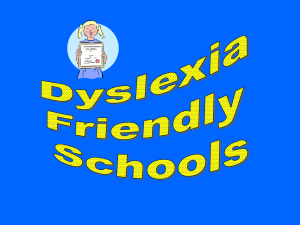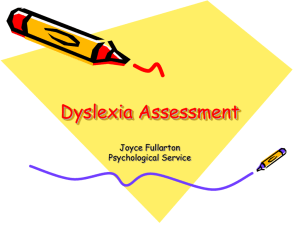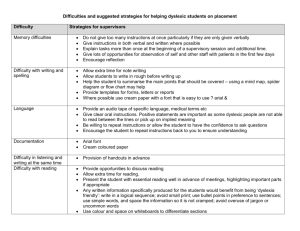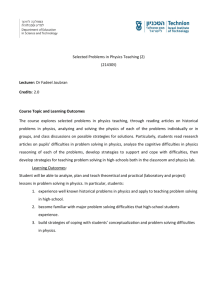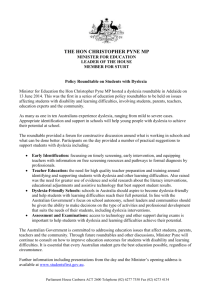Dyslexia and the Use of Assistive Technology
advertisement
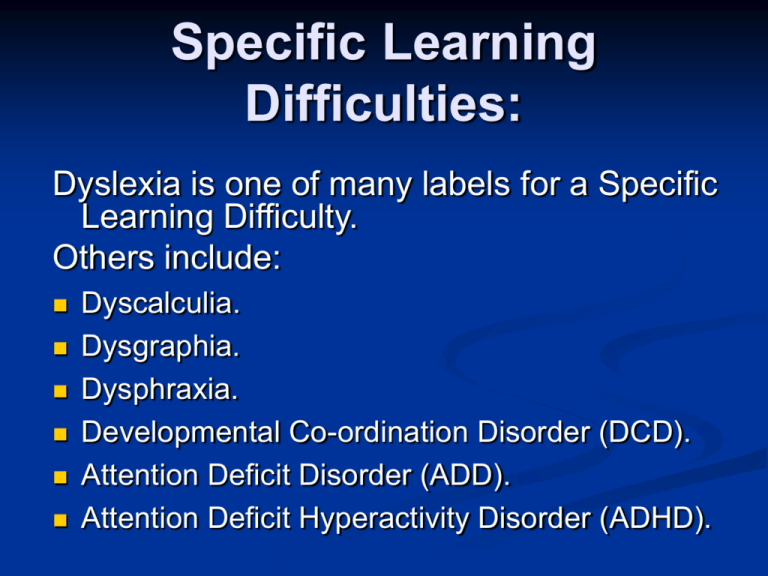
Specific Learning Difficulties: Dyslexia is one of many labels for a Specific Learning Difficulty. Others include: Dyscalculia. Dysgraphia. Dysphraxia. Developmental Co-ordination Disorder (DCD). Attention Deficit Disorder (ADD). Attention Deficit Hyperactivity Disorder (ADHD). Specific Learning Difficulties Specific Learning Difficulties are usually caused by inherent, sensory, physical, or neurological factors and they: Can cause a person to learn differently. Are not linked to intellectual impairment (except incidentally). May coincidently exist with problems with motor co-ordination / skills attention, social perception and social interaction. Are life-long. Specific Learning Difficulties affects the learning of about 4%-10% of all people. Dyslexia Greek "dys" meaning difficulty, and "lexis" meaning words. Sometimes known as ‘specific learning difficulty’, dyslexia is a problem in the acquisition of reading, spelling and writing. Frequently mathematics and aspects of spoken language are affected. The term ‘developmental dyslexia’ is often used to describe those who fail to acquire written language easily and whose written language is delayed. Characteristics of Dyslexia Common characteristics of Dyslexia include: Short Term Memory Difficulties. Reading and Writing Difficulties. Visual Processing Difficulties. Auditory Processing Difficulties. Time Management Difficulties. Organisational Difficulties. Persisting factors. There are many persisting factors in dyslexia, which can appear from an early age. They will still be noticeable when the dyslexic child leaves school Obvious 'good' and 'bad' days, for no apparent reason, Confusion between directional words, e.g. up/down, in/out, Difficulty with sequence, e.g. coloured bead sequence, later with days of the week or numbers, A family history of dyslexia/reading difficulties. Pre-school Language Has persistent jumbled phrases, e.g. 'cobbler's club' for 'toddler's club' Use of substitute words (‘near misses’) e.g. ‘lopital’ for ‘hospital’, ‘lampshade’ for lamppost. Hesitates because he cannot find the words he needs and cannot remember the name for familiar objects e.g. 'table, chair'. Difficulty learning nursery rhymes and rhyming words, e.g. 'cat, mat, sat'. Confuses ‘up’ and ‘down’ and ‘left’ and ‘right’. Later than expected speech development. Pre-school non-language indicators. May have walked early but did not crawl - was a 'bottom shuffler' or 'tummy wriggler'. Persistent difficulties in getting dressed efficiently and putting shoes on the correct feet. Enjoys being read to but shows no interest in letters or words. Is often accused of not listening or paying attention. or having difficulty in carrying out more than one instruction at a time. Excessive tripping, bumping into things and falling over. Difficulty with catching, kicking or throwing a ball; with hopping and/or skipping. Difficulty with clapping a simple rhythm. Pre-school non-language indicators 2 When colouring in the child has difficulty in keeping the colours within the shape. • When colouring in the child may have difficulty in keeping within the lines. All young children may make mistakes like these and many will grow out of them, but it is the length of time these continue which give vital clues as to possible signs of dyslexia. Primary school age 1. Has particular difficulty with reading and spelling. Puts letters and figures the wrong way round. Has difficulty remembering tables, alphabet, formulae etc. Leaves letters out of words or puts them in the wrong order. Still occasionally confuses 'b' and 'd' and words such as 'no/on'. Primary school age 2 Still needs to use fingers or marks on paper to make simple calculations. Poor concentration. Has problems understanding what he/she has read. Takes longer than average to do written work. Problems processing language at speed. Primary school age non-language indicators: Has difficulty with tying shoe laces, tie, dressing. Has difficulty telling left from right, order of days of the week, months of the year etc. Surprises you because in other ways he/she is bright and alert. Has a poor sense of direction and still confuses left and right. Lacks confidence and has a poor self image. Aged 12 or over. As for primary schools, plus: Still reads inaccurately. Still has difficulties in spelling. Needs to have instructions and telephone numbers repeated. Gets 'tied up' using long words, e.g. 'preliminary', 'philosophical'. Confuses places, times, dates. Has difficulty with planning and writing essays. Has difficulty processing complex language or long series of instructions at speed Aged 12 or over non-language indicators: Has poor confidence and self-esteem. Has areas of strength as well as weakness. Theoretical Explanations of Dyslexia Its explained in the literature at different levels Biological Level Cognitive Level Behavioural level Biological Level Right Hemisphere Preference Right Hemisphere skills such as visual spatial awareness dominate over left hemisphere skills involving language, symbols , reading Inhibited Primary Movement Genetic Chromosome Research MRI Characterisation Inheritance Cognitive Level Working Memory Phonological Processing Difficulty Processing Speed Visual Processing Difficulty Automaticity Reading Fluency Behavioural Level Speech and Language Difficulty Pattern of errors in reading and writing Difficulties with Rote learning Sequencing difficulties Poor concentration Organization Left Right Confusion Self esteem Effects of Dyslexia The effects of dyslexia may include: Making errors with numbers (telephone numbers, reversing bus number etc). Difficulty with organisational skills, including time management. Misplacing personal items such as keys. Making mistakes copying things down (instructions, number etc). Effects of Dyslexia II Also: Confusing dates, and missing appointments. Difficulty with orientation, e.g. with maps or in strange towns. Confusing left and right. Problems with explaining ideas and concepts, particularly on paper. Word finding difficulties, and mispronunciation of long words. Research shows that dyslexic people do improve with: Small group (or one-to-one) support. As early identification and remediation as possible. Understanding and encouragement. A structured multi-sensory method of teaching e.g. sound-symbol associations, and simultaneous oral spelling. Research shows that dyslexic people do improve with: A structured approach based on established phonetic principles. Matching task to learner - ie. individualised instruction based on careful assessment. Teaching to strengths and the person’s learning style to help remediate the weaknesses whilst utilising their strengths. Mnemonics and “concrete” aids. Help with organisation. Patience and understanding Dyslexic people do not improve with Unspecific remedial methods, i.e. more reading, more spelling. In a child's particular instance, being left to “grow out of it”. Training visual or auditory perception alone (unless within written language itself). Punishments, threats of being disciplined or sacked, ridiculed in front of others. Inappropriate labelling, name calling e.g. thick, stupid, lazy. Processes of Reading Goal of Reading is to understand a piece of Text (Ellis 1993) Basic processes Eye Movement Letter Identification Word Identification Word Meaning Syntax Semantics Discourse Integration Eye Movements Saccades ( Eyes move laterally across the page in a series of jerky jumps called Saccades) Around 10% of Saccades in Reading move backwards Saccades take around 10-20 milliseconds to complete and are separated by fixations lasting around 200-250 milliseconds The length of each saccade covers around 8 letters Information is only extracted during the fixation Fixations Rare words are fixated for longer Predictable words from context are fixated for a shorter time Words preceded by a rare word have a longer Fixation time (Spillover) Words that are not fixated are Common, Short or Predictable Perceptual Span Perceptual Span (effective field of view) Total Perceptual Span is the total area from which useful information is extracted. It extends typically 3 or 4 letters to the left of the fixation and up to 15 letters to the right. There are two other main spans the letter identification span and the word identification span Word Identification Span is the shortest Letter and Word Identification Letter Identification does not have to be fully complete before Word Identification Word Superiority Effect (Reicher 1969) Task - Identify Letters in positions in words Performance is superior when word is known This indicates that knowledge about the word informs the ID of letters. Main stages in Natural Language Understanding Prosody (Rhythm ,Intonation, Metre) Phonology ( Phonetics of Words) Morphology (Word and Phrase Construction) Syntax (Grammars, Sentence Structure) Semantics (Meaning) Pragmatics (Effect of Language, Chants etc) World Knowledge Elements of Reading (National Reading Panel) phonemic awareness phonics fluency vocabulary text comprehension Word Recognition Clues phonics sight words context clues structural analysis Towards Reading Try to provide a positive, productive period to contribute actively to the lesson. Try to give the child the opportunity to practise his reading skills and show off his ability. Participate in his reading experience instead of listening. Encourage reading by looking at books together. Rag books, board books are great for younger children. Read aloud together - use expressive features, different voices to encourage the child to try this too. Towards Reading Joining a library can help establish a good attitude towards books. Encourage the child to look at things for information e.g. cereal box, streets, roads,maps. Reading should be fun so try not to pressure him/her and don’t expect too much too Towards Reading Read stories at bedtime where it is quiet and you can be comfortable together. Make sessions fun by playing around with rhyming words and associated words. Read books that are comparable with his reading ability. There are many graded series that can be purchased even for the older child. To build self-belief it is sometimes better to start on an easier book to encourage and boost his confidence. Praise him for the attempted words he gets correct. Always look for the things that he can do rather than what he cannot. Towards Reading Use bookmarkers to keep place in a book. Encourage the child to try to decode the words himself. Don’t leave him to struggle though! If he is stuck - give him a clue e.g. look at the beginning of the word, are there familiar letters, look at the picture, look at the words around, try giving the first sound. Give him the chance to `make up’ stories whilst you write them down for him. Then as he progresses, ask him to write them down as clearly and as accurate as he can. In time, you could ask him to transfer his story onto a PC to make it more presentable. Activities to help with Reading 1 1. Say nursery rhymes together; they help to encourage rhythm at an early age. 2. Finger play e.g. poems and songs which have hand actions. 3. Read to the child: poetry, (especially funny or nonsense poems) and stories. 4. Act out a mime of a rhyme or something that has happened and then guess the mime. 5. Find pictured to talk about and help the child to notice details e.g. Is the man in front of or behind the lady? Is the boy climbing under or over the gate? Activities to help with Reading 2 6. Play games e.g. hunt the thimble and say “is it inside the pot, under the pot, on top of the pot? 7. Watch television together. It can be a useful way of learning if you talk about what is happening. 8. There are some very good puzzle books e.g. joining dots, mazes and simple picture crosswords are all useful. 9. Encourage the child to help with tasks e.g. laying/cleaning the table, setting out play things and putting them away. Types of Reading Text Materials narrative text materials stories, fiction, inspirational informational text material textbooks, content area materials, instructional materials Literature-Based Reading Instruction Strong relationships among language systems: oral language, reading, writing. Immerse children in language and books. Children should have early experiences with writing. Children need time for independent reading. Explicit Code-Emphasis Instruction Systematic, direct instruction of alphabet code Mapping linkage of letters and words Early attainment of decoding skills Children need an early start in reading Improving Fluency Repeated reading Predictable books Neurological impress method Read-along method Reading Comprehension Depends upon what reader brings to the text A language process A thinking process Requires interaction with the text Improving Reading Comprehension Building vocabulary Using basal readers Activating background knowledge Language experience method Reading-writing connection Learning strategies Encourage wide reading K-W-L K What we know W What we want to find out L What we have learned Word Webs Specific Remedial Methods Multisensory methods Orton-Gillingham Wilson Fernald Others Reading Recovery Direct Instruction Using Computers Dyslexia and the Use of Assistive Technology Characteristics of Specific Learning Difficulties The following are common characteristics of Specific Learning Difficulties: Memory Difficulties Writing Difficulties Reading Difficulties Visual Processing Difficulties Auditory Processing Difficulties Time Management Difficulties Organisational Difficulties Memory Difficulties Audio Recorder Sticky Notes Electronic To Do Lists / Task Lists Organisational Tools Mind Mapping Software Outline Tool Keyboarding Smart Keyboards Personal Digital Assistants (PDAs) Desktop or Laptop Computer Visual Difficulties Good lighting. Coloured Overlays. Choose a clear font and think about the visual presentation. Reading from the screen Text to Speech can be useful for students with an auditory learning style. Text to speech can be used for reading a whole range of text documents (web pages, Word Documents and PDFs etc). Text to speech can be used in conjunction with OCR to read printed books or papers. Writing on the Screen Good Keyboarding skills. Speech Recognition programs. Spell Checking. Word Prediction. Conclusion Technology can help support the needs of students with specific learning difficulties. Sometimes simple technology can work more effectively. Technology does not replace the need for specialist learning support, but it does give students more independence and freedom to work using their skills and
